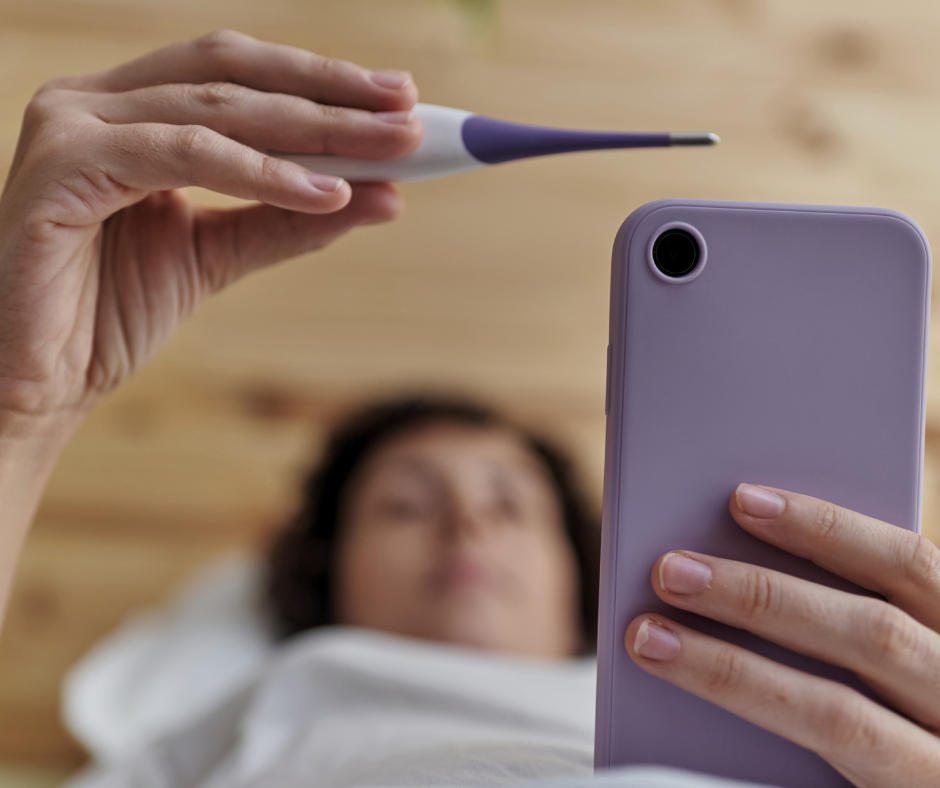

Comparing Fertility Tracking Devices Like Oura and Proov
Summary
Reflection Questions
Journal Prompt
Modern technology and an increasing focus on the ways in which our bodies differ from men’s is reshaping our understanding of women’s health (which is long overdue). Gone are the days of relying solely on calendars and guesswork when it comes to fertility. Today, innovative devices ranging from wearable sensors to hormone-analyzing systems put insightful cycle data right at your fingertips. Let’s explore the latest advancements in fertility tracking and how they can provide personalized insights into your reproductive health. In addition to comparing fertility tracking devices like Oura and Proov, we’ll also answer your FAQs about insurance coverage and delve into the privacy policies of these apps.
Types of Fertility Tracking Devices Available Today
Basal Body Temperature (BBT) Thermometers


Basal Body Temperature (BBT) thermometers are specialized devices used to track a woman’s basal body temperature, which is the body’s lowest temperature during a period of rest, typically measured immediately after waking up in the morning. BBT thermometers are more sensitive than regular thermometers, as they can detect minute changes in temperature, often to the hundredth of a degree. This sensitivity is crucial because the rise in body temperature that occurs after ovulation is typically very slight, usually around 0.4 to 1.0 degrees Fahrenheit. Women chart their daily temperatures using paper charts or digital apps to identify the subtle rise in temperature that indicates ovulation has occurred. This method is often used as part of fertility awareness for both trying to conceive and as a natural contraceptive method.
The effectiveness of BBT tracking depends heavily on consistency and accuracy in measuring. It is important to take the temperature at the same time each morning, immediately upon waking and before any physical activity, as even small actions like getting out of bed can alter the reading. While BBT thermometers can indicate when ovulation has occurred, they do not predict ovulation; the temperature rise happens after the ovary releases an egg. Therefore, while helpful for understanding one’s cycle patterns over time, BBT tracking requires several cycles of data to effectively predict fertile windows and is often used in conjunction with other fertility tracking methods for best results.
Wearable Fertility Trackers
Wearable fertility trackers are devices designed to be worn on the body, often as bracelets or armbands, which monitor various physiological indicators related to fertility. These devices typically track data such as skin temperature, heart rate, and sleep patterns, which are then analyzed using algorithms to predict or confirm ovulation periods. Wearables offer continuous data collection, providing a comprehensive picture of a woman’s menstrual cycle and fertile window. The convenience of these devices lies in their ability to passively collect data while the wearer goes about their daily activities, removing the need for daily manual input typically associated with traditional fertility tracking methods.
Wearable fertility trackers use this data to offer predictions about the user’s fertility status in real-time, which can be particularly useful for planning pregnancy or tracking menstrual health. They are connected to smartphone apps where the collected data is displayed in an easy-to-understand format. Users can view their current fertility status, receive notifications about upcoming fertile windows, and track changes in their cycle over time. These devices are especially popular among women looking for a hassle-free way to manage fertility that integrates seamlessly into their everyday life, providing both convenience and a high level of insight into their reproductive health.
Fuel your creative fire & be a part of a supportive community that values how you love to live.
subscribe to our newsletter
*please check your Spam folder for the latest DesignDash Magazine issue immediately after subscription


Ovulation Predictor Kits (OPKs)
Ovulation Predictor Kits (OPKs) are over-the-counter tests that help women determine the time in their menstrual cycle when they are most likely to ovulate. These kits work by detecting the presence of luteinizing hormone (LH) in urine. LH surges approximately 24 to 36 hours before ovulation, making its detection a useful indicator of the fertile window. OPKs involve applying urine to a test stick or strip and reading the results, which are often displayed as lines or symbols indicating whether the LH surge is occurring.
The primary benefit of OPKs is their ability to provide advance notice of ovulation, allowing for optimal timing of intercourse for conception. They are straightforward to use and accessible, making them a popular choice among women trying to conceive. However, they can be less effective for women with irregular menstrual cycles or conditions like Polycystic Ovary Syndrome (PCOS), which can affect hormone levels. For these women, LH levels may be irregular or continuously elevated, leading to false positives or difficulty in interpreting the results.
Hormone Monitoring Devices


Hormone monitoring devices are advanced fertility tools that measure specific hormone levels over time to provide insights into a woman’s menstrual cycle and fertility status. These devices often use urine or saliva samples to test for hormones such as estrogen, progesterone, and luteinizing hormone (LH), which play key roles in the menstrual cycle. By tracking these hormone levels, the devices can offer precise information about the timing of ovulation and the overall hormonal health, which is particularly beneficial for diagnosing and managing fertility issues.
These devices typically come with a reader or analyzer that interprets the test strips or cartridges. Users provide samples at specified times throughout their cycle, and the results are either read digitally on the device or synced to a smartphone app. This allows for continuous tracking and data collection that can be reviewed over time to identify patterns or anomalies in hormone levels. Hormone monitoring devices are highly valuable for women experiencing fertility issues or irregular cycles, as they provide detailed, personalized data that can help healthcare providers offer more tailored treatment and advice.
Answering Your FAQs About Fertility Tracking Devices
Are these devices ever covered by insurance?
Fertility tracking devices may be covered by insurance, but this largely depends on the type of insurance plan you have and the specific fertility device. Some health insurance plans, especially those that include health savings accounts (HSAs) or flexible spending accounts (FSAs), may allow users to purchase fertility trackers using pre-tax dollars, which can significantly reduce out-of-pocket costs.
For example, the Mira Fertility Tracker is noted to be eligible for purchase with HSA/FSA funds in many cases, which can effectively lower its cost. However, coverage can vary widely, so it’s important to check with your insurance provider to determine if a specific fertility tracking device is covered under your plan. Additionally, some manufacturers may offer assistance programs or discounts that can help with affordability if insurance coverage is not available.
Submitting a Superbill for Coverage


You can submit a superbill to your insurance for coverage of fertility tracking devices, depending on the device and your insurance policy. A superbill is a detailed form used by healthcare providers that outlines services provided to a patient. It includes all the necessary information such as service codes, diagnosis codes, and provider information, which the patient can then submit to their insurance company for potential reimbursement.
To use a superbill for a fertility tracking device, you would first need to ensure that the device qualifies under your specific insurance plan’s guidelines for medical necessity. This might involve demonstrating that the device is required for diagnosing or treating a medical condition, such as fertility issues. It’s important to check with both the manufacturer of the device to see if they can provide a superbill, and with your insurance provider to understand what is covered under your plan. Some providers might also require a prescription from a healthcare provider to support the claim. Always verify the details with your insurance company to ensure compliance with their policies and to maximize your chances of receiving reimbursement.
For more information about submitting superbills to your insurance provider, check out this article on DesignDash.
Do these devices actually help you get pregnant?


Fertility tracking devices can indeed help in the process of getting pregnant by providing valuable insights into one’s fertility window and optimal times for conception. These devices often measure various physiological markers like basal body temperature, hormone levels, or even changes in cervical mucus to predict ovulation with a high degree of accuracy.
For instance, devices like OvuSense and Mira give detailed insights into hormone fluctuations and core body temperature changes, which can help pinpoint the most fertile days. However, while these devices enhance the understanding of one’s fertility cycle and improve the timing of intercourse, they do not directly treat underlying fertility issues. Users often find these devices especially helpful in taking a proactive approach to conception, providing them with more control and better planning capabilities during their fertility journey.
Are they a form of birth control?


Fertility tracking devices are not considered a form of birth control in the traditional sense of preventing pregnancy through hormonal or barrier methods. Instead, they are part of a category known as fertility awareness methods (FAMs), which involve identifying the fertile window during a woman’s menstrual cycle to either target or avoid intercourse depending on the individual’s goals. While some individuals use these devices to avoid pregnancy by abstaining or using other forms of protection during the fertile period, the effectiveness of FAMs as a contraceptive method can vary significantly.
Studies suggest that with perfect use, some FAMs can be quite effective, but they generally require strict adherence to daily tracking and interpretation of data. Therefore, while these devices can assist in planning around fertility, they should not be relied upon solely for contraception without additional protective measures or thorough understanding of their use.
Can I use them if I have irregular cycles (irregular ovulation and periods)?


Fertility tracking devices can be particularly useful for individuals with irregular cycles, as they provide detailed physiological data that can help identify patterns and predict ovulation even when cycles are not consistent. Devices like Mira and OvuSense are designed to adapt to unique cycle lengths and changes by tracking specific hormones and core body temperatures, respectively. This capability allows them to offer valuable insights to those who may not benefit from standard ovulation predictors, which often assume a typical cycle length.
However, it’s important to note that while these devices can enhance understanding and help manage irregular cycles, they may require a longer period of data collection to adjust to the individual’s specific cycle patterns. Users with highly irregular cycles might also benefit from consulting with a healthcare provider to interpret the data effectively and to rule out any underlying health issues that might be causing the irregularities.
Are they safe?


Fertility tracking devices are generally considered safe for most users. These devices typically involve non-invasive measurements such as skin temperature, heart rate, or hormone levels from urine samples. There are very few risks associated with the use of these devices, as they do not involve any pharmaceuticals or invasive procedures. Some devices, like OvuSense, involve inserting a sensor vaginally, which carries minimal risks similar to those associated with using tampons, such as irritation or infection if not used hygienically.
Overall, the safety profile of these devices is favorable, and they are widely used by individuals looking to gain a deeper understanding of their fertility without significant health risks. However, as with any health device, it’s advisable to use them according to manufacturer instructions and consult a healthcare provider if there are any concerns about their use or the data they provide.
8 Fertility Tracking Devices, Kits, and Subscription Services to Consider
Ava Fertility Tracker
The Ava Fertility Tracker is designed as a wearable device that simplifies fertility tracking by gathering physiological data as users sleep. It measures various indicators such as skin temperature, resting pulse rate, breathing rate, and sleep quality, which are analyzed to predict the user’s fertile window. This data is synchronized daily with a companion smartphone app, which uses an algorithm to identify potential fertility patterns. Ava is celebrated for its ease of use, requiring minimal user intervention beyond wearing the bracelet at night. The device is particularly beneficial for women who prefer a non-invasive and straightforward method to track their fertility.
Ava offers several plans with varying features and guarantees, such as a refund if pregnancy is not achieved within a specified period under certain plans. It has been highly rated for its accuracy and the comprehensive insights it offers into one’s reproductive health. Users often express satisfaction with the device’s ability to provide real-time results and a detailed view of their health, which goes beyond just fertility and includes monitoring of general wellness aspects like sleep and stress.
Mira Fertility Tracker
The Mira Fertility Tracker takes a more analytical approach to fertility tracking, utilizing a handheld device that measures hormone levels directly from urine. It’s specifically noted for its ability to track concentrations of luteinizing hormone (LH) and estrogen, providing precise data on when ovulation occurs. This level of detail makes Mira an excellent choice for those with irregular cycles or those who want to gather extensive data about their fertility. The associated app also offers predictions and personalized health insights based on the hormone data collected.
Mira is particularly appreciated for its high accuracy and the empowerment it offers women in understanding their reproductive health. The device uses single-use test wands, which can be inserted into the analyzer to read hormone levels. Despite the recurring cost of the wands, users find the device valuable for its detailed tracking and the ability to predict ovulation accurately, making it easier to plan for conception.
Tempdrop
Tempdrop is a wearable sensor that provides a hassle-free way to track basal body temperature, an important fertility indicator. Worn on the arm overnight, Tempdrop captures temperature data continuously, offering insights into the subtle changes that occur before and after ovulation. Its algorithm adjusts for sleep disturbances and irregular sleep patterns, increasing the accuracy of its predictions over time. This device is particularly useful for women who are looking for a reliable and non-invasive method to track their ovulation cycle, especially those with irregular schedules or who do not want to deal with daily manual temperature readings.
Beyond temperature, Tempdrop’s sensor also monitors motion, allowing it to differentiate between sleeping patterns and actual restful sleep, which can impact temperature readings. The data collected syncs with the Tempdrop app but can also be used with other fertility apps, which is a major plus for users who might already be using other platforms for fertility tracking. This flexibility, combined with the device’s ease of use, has made Tempdrop a popular choice among those tracking fertility for natural family planning or conception purposes.
OvuSense
OvuSense provides a unique approach to fertility tracking by using a vaginal sensor to measure core body temperature overnight. This method offers highly accurate readings that are directly influenced by hormonal changes associated with the ovulation cycle. The OvuSense system includes an app that analyses the temperature data to predict ovulation up to 24 hours in advance and confirm it with 99% accuracy, a level of precision that is particularly valuable for women with irregular or hard-to-predict cycles. The device is clinically validated and is often recommended for use under the guidance of fertility specialists.
The comprehensive data collected by OvuSense not only aids in conception but also helps in monitoring general reproductive health and identifying potential issues. It’s particularly favored by those who need a reliable, medical-grade tracker that can provide detailed insights into their fertility. OvuSense also offers different subscription plans that include advanced features like a nurse consultation if conception isn’t achieved within a set timeframe, adding an extra layer of support for users.
Daysy
The next fertility tracking device on our list is Daysy. Daysy is a fertility monitor that focuses on basal body temperature measurements to determine fertile windows. Each morning, users measure their temperature with the Daysy thermometer, and the data is then processed by an algorithm to indicate fertile and non-fertile days on the device itself. Daysy boasts a high accuracy rate and is designed for those who prefer a straightforward, minimal-interaction approach to fertility tracking. Its ease of use and quick integration of menstrual cycle data make it a friendly choice for many users.
What sets Daysy apart is its dedication to providing a natural and hormone-free method of family planning. The device’s ability to store several months of data allows for long-term analysis of menstrual cycles, which can be incredibly informative for users looking to understand their patterns or plan pregnancies accordingly. Daysy’s approach is highly appreciated by users who value simplicity and scientific reliability in their data monitoring fertility. Daysy’s non-invasive, easy-to-use system supports its users’ journey toward understanding their reproductive health, leveraging technology to make family planning as intuitive as possible.
OvaCue
OvaCue is distinguished by its innovative approach to fertility tracking, utilizing sensors to measure electrolyte levels in saliva and cervical mucus to predict and confirm ovulation. This dual-sensor system provides a comprehensive overview of a woman’s fertility status, with color-coded data displayed on a handheld monitor. The use of electrolyte monitoring is based on the premise that hormonal changes affecting ovulation also alter electrolyte levels, providing a unique and scientifically grounded method of fertility assessment.
OvaCue’s technology is especially beneficial for those seeking a detailed understanding of their fertile window. The device includes access to the OvaGraph app, where users can log and analyze their fertility data over time, gaining insights into their menstrual cycle and overall reproductive health. This method is one of the more advanced options on the market, appealing to users who appreciate a high-tech approach to natural fertility tracking. It’s particularly recommended for its educational value, helping users learn more about their bodies and the factors influencing their fertility.
Proov
Proov is a pioneering home testing kit designed to measure the presence of PdG (pregnanediol glucuronide), a metabolite of progesterone, in urine. Progesterone is crucial for supporting pregnancy, and its levels can provide essential insights into a woman’s luteal phase—the post-ovulation period critical for implantation and early pregnancy. By confirming that sufficient progesterone is being produced after ovulation, Proov helps users assess their daily fertility status and potential for successful conception.
Proov is celebrated for its simplicity and effectiveness. The test strips are used at home and work similarly to an ovulation predictor kit, but instead of detecting ovulation, they help verify the body’s response to it. This information can be vital for individuals experiencing difficulties in conceiving, as low PdG levels can indicate issues that might need medical attention. Proov’s approach empowers users with quick, direct feedback about their reproductive health, making it a valuable tool in fertility planning and early pregnancy monitoring.
Natural Cycles


Natural Cycles is an FDA-cleared app that functions as a digital form of birth control. It uses a woman’s daily basal body temperature readings along with a highly sensitive algorithm to identify her fertile window. How does it work? You take your temperature daily with a BBT thermometer and input the data into the app. The algorithm analyzes your cycle patterns and pinpoints your fertile days, displaying them as “red” (no unprotected sex) or “green” days. Natural Cycles claims 93% efficacy with typical use and 98% with perfect use, which is comparable to hormonal birth control pills.
Partnership with Oura Ring
The Oura Ring is a smart ring that tracks various health metrics including sleep, heart rate, and body temperature changes continuously throughout the night. Oura partners with Natural Cycles. Your Oura Ring’s precise temperature trend data can be seamlessly synced with the Natural Cycles app for its algorithm to use. This eliminates the need to take your temperature manually each morning.
The ring also tracks overall health trends, readiness scores, and sleep patterns, offering a wider picture of factors that might affect your cycles. Oura claims that its temperature readings are highly accurate and more consistent than single daily measurements. If you’re strict with daily temperature checks (whether manual or via Oura), the Natural Cycles algorithm is effective. However, it requires discipline for those who want the highest level of pregnancy prevention.
Currently, Oura’s cycle tracking features provide period predictions and temperature data but don’t offer the “green” and “red” day determinations that Natural Cycles provides. You need an Oura Ring (several generations are compatible) along with a paid Natural Cycles subscription.
Final Thoughts: Exploring the Privacy Policies of Devices Like Proov and Oura


When considering the privacy policies of fertility tracking devices, it’s important to understand how each company handles sensitive health data—especially in today’s political climate. Most fertility tracking devices collect a variety of personal health information, including menstrual cycle data, basal body temperature, hormonal levels, and sometimes even sleep patterns and physical activity. This information is necessary to provide users with accurate predictions regarding their fertility windows and overall health insights.
Data Usage
The information collected is primarily used to improve the functionality of the device and personalize the user experience. Additionally, it can be used for research to enhance the device’s algorithms or for sharing insights with medical professionals, should the user choose to do so.
Data Sharing and Security


Privacy policies typically cover details on how data may be shared with third parties. Companies often assert that they do not sell personal data to third parties without consent, but may share anonymized data for scientific research or improvement of the device’s functions. Data security is paramount, with most companies employing advanced encryption and other security measures to protect user data from unauthorized access.
User Rights


Users generally have rights regarding their data, including accessing their data, requesting corrections to inaccuracies, and sometimes even exporting their data to use with other services. Many policies also allow users to request the deletion of their data under certain conditions.
For details specific to any fertility tracking device, please check the privacy policy directly on the manufacturer’s website or within the app associated with the device. This policy should provide detailed information on how your data is handled, your rights as a user, and how to exercise those rights. Always ensure you read and understand these policies before using a new health device, especially when it involves such sensitive personal information.
Design Dash
Join us in designing a life you love.
-
Why Interior Designers Should Consider an Online Color Theory Class
Read on to learn more about this discipline and for a short list of our favorite online color theory classes to get you started.
-
How to Avoid Overpaying Estimated Taxes as a Firm Owner
Most firm owners must submit quarterly estimated tax payments based on their AGI. Here’s how to avoid overpaying estimated taxes as a design business owner.
-
Make It a Habit: The Key to Keeping New Year’s Resolutions
Behavioral scientists often argue that the key to the persistence and success of New Year’s resolutions lies in habit formation psychology.
-
Get to Know the DesignDash Team Through a Q&A at Our 2024 Holiday Party!
From favorite traditions to proudest moments, get to know the team and what inspires them for the new year by reading our 2024 holiday Q&A!
-
Your Digital Footprint: Why Entrepreneurs Need to Think Beyond Social Media
Social media is great for today, but creative entrepreneurs need a lasting online presence. Learn how to expand your digital footprint with websites, newsletters, and features that showcase your work for years to come.
-
Winter Capsule Wardrobe: Staying Stylish This Season with Just 10 Pieces
Simplify your mornings and elevate your style with our guide to creating a winter capsule wardrobe!








